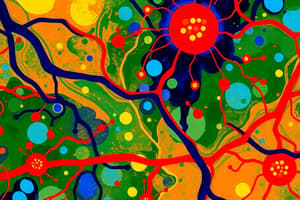Podcast
Questions and Answers
What is the primary mechanism by which G-protein-coupled receptors exert their effect on target proteins?
What is the primary mechanism by which G-protein-coupled receptors exert their effect on target proteins?
- They sequester second messengers within the cytoplasm.
- They undergo a conformational change that releases neurotransmitters.
- They directly open ion channels in the plasma membrane.
- They activate an enzyme or ion channel through GTP binding. (correct)
Which of the following statements accurately describes the role of adenylyl cyclase in cell signaling?
Which of the following statements accurately describes the role of adenylyl cyclase in cell signaling?
- It catalyzes the formation of cyclic AMP from ATP. (correct)
- It serves as a direct receptor for signaling molecules.
- It binds to the ligand-gated channels to modify their function.
- It converts cyclic AMP to ATP in the presence of GTP.
What occurs following the binding of a signaling molecule to a G-protein-coupled receptor?
What occurs following the binding of a signaling molecule to a G-protein-coupled receptor?
- The receptor becomes inactive and releases GDP.
- GDP is exchanged for GTP, activating the G protein. (correct)
- The signaling molecule is transported into the nucleus.
- The receptor undergoes degradation within the cell.
Which molecule is most commonly involved in the signaling cascade initiated by G-protein-coupled receptors?
Which molecule is most commonly involved in the signaling cascade initiated by G-protein-coupled receptors?
Which type of receptor directly opens an ion channel upon ligand binding?
Which type of receptor directly opens an ion channel upon ligand binding?
What triggers many biological processes through increases in calcium levels?
What triggers many biological processes through increases in calcium levels?
Which class of receptors primarily involves dimerisation upon signaling molecule binding?
Which class of receptors primarily involves dimerisation upon signaling molecule binding?
What is the primary function of Ras in receptor tyrosine kinase signaling?
What is the primary function of Ras in receptor tyrosine kinase signaling?
What describes the action of steroid hormones in the context of intracellular receptors?
What describes the action of steroid hormones in the context of intracellular receptors?
What is produced by the adrenal glands in response to stress and primarily affects metabolism?
What is produced by the adrenal glands in response to stress and primarily affects metabolism?
Which signaling pathway is activated by the binding of signaling molecules to G-protein coupled receptors?
Which signaling pathway is activated by the binding of signaling molecules to G-protein coupled receptors?
What do G-protein coupled receptors primarily regulate within the cell?
What do G-protein coupled receptors primarily regulate within the cell?
What is a key characteristic of enzyme-coupled receptors, especially receptor tyrosine kinases?
What is a key characteristic of enzyme-coupled receptors, especially receptor tyrosine kinases?
What component is transformed during the activation of Ras by receptor tyrosine kinases?
What component is transformed during the activation of Ras by receptor tyrosine kinases?
Which type of receptors crosses the plasma membrane and binds to intracellular receptors?
Which type of receptors crosses the plasma membrane and binds to intracellular receptors?
What type of signaling involves hormones that are distributed throughout the body?
What type of signaling involves hormones that are distributed throughout the body?
In which type of signaling do cells release signals that act locally on nearby cells?
In which type of signaling do cells release signals that act locally on nearby cells?
What is the function of intracellular signaling proteins?
What is the function of intracellular signaling proteins?
Which class of receptors opens or closes in response to the binding of a signaling molecule, thus allowing the flow of ions across the membrane?
Which class of receptors opens or closes in response to the binding of a signaling molecule, thus allowing the flow of ions across the membrane?
What determines the specific set of signals a cell responds to in a multicellular organism?
What determines the specific set of signals a cell responds to in a multicellular organism?
What kind of signaling occurs when a cell binds a signal molecule directly to a receptor on an adjacent cell?
What kind of signaling occurs when a cell binds a signal molecule directly to a receptor on an adjacent cell?
Which of the following is NOT a class of cell surface receptors?
Which of the following is NOT a class of cell surface receptors?
Which statement about molecular switches is correct?
Which statement about molecular switches is correct?
What is the role of effector proteins in cell signaling?
What is the role of effector proteins in cell signaling?
Which type of signal transmitter is crucial for the nervous system and muscle cell activity?
Which type of signal transmitter is crucial for the nervous system and muscle cell activity?
Flashcards
Ion-channel coupled receptors
Ion-channel coupled receptors
These are a type of cell surface receptor that opens a channel to let ions pass through when a specific molecule binds to them. This process is also known as ligand-gated ion channels.
G-protein coupled receptors
G-protein coupled receptors
These receptors are linked to G proteins, which are like messenger molecules inside the cell. These receptors bind to signaling molecules and activate G proteins, starting a chain reaction within the cell.
What does adenylyl cyclase do?
What does adenylyl cyclase do?
This is a key enzyme involved in signaling pathways triggered by G-protein coupled receptors. It produces a second messenger called cAMP.
What is Cyclic AMP (cAMP)?
What is Cyclic AMP (cAMP)?
Signup and view all the flashcards
What does Protein Kinase A (PKA) do?
What does Protein Kinase A (PKA) do?
Signup and view all the flashcards
Signal transduction
Signal transduction
Signup and view all the flashcards
Paracrine signaling
Paracrine signaling
Signup and view all the flashcards
Neuronal signaling
Neuronal signaling
Signup and view all the flashcards
Contact-dependent signaling
Contact-dependent signaling
Signup and view all the flashcards
Cellular response to signals
Cellular response to signals
Signup and view all the flashcards
Receptor protein role
Receptor protein role
Signup and view all the flashcards
Molecular switches
Molecular switches
Signup and view all the flashcards
Hormones
Hormones
Signup and view all the flashcards
Intracellular signaling proteins
Intracellular signaling proteins
Signup and view all the flashcards
Glycogen breakdown in skeletal muscle
Glycogen breakdown in skeletal muscle
Signup and view all the flashcards
What are G-protein coupled receptors?
What are G-protein coupled receptors?
Signup and view all the flashcards
What is the function of G-protein coupled receptors?
What is the function of G-protein coupled receptors?
Signup and view all the flashcards
What are G-proteins?
What are G-proteins?
Signup and view all the flashcards
What is cyclic AMP?
What is cyclic AMP?
Signup and view all the flashcards
What is phospholipase C?
What is phospholipase C?
Signup and view all the flashcards
What are DAG and IP3?
What are DAG and IP3?
Signup and view all the flashcards
What are enzyme-coupled receptors?
What are enzyme-coupled receptors?
Signup and view all the flashcards
What are receptor tyrosine kinases?
What are receptor tyrosine kinases?
Signup and view all the flashcards
What is Ras?
What is Ras?
Signup and view all the flashcards
Study Notes
Cell Communication
- Cells in multicellular organisms need to respond to external and internal changes, which often involves adapting or coordinating behavior.
- Cells need to send and receive signals.
- Cellular communication involves different forms of information that can require conversion from one form to another.
- Signal transduction is a process of converting a signal.
- Typical cellular communication describes the signalling cell producing a signal and this signal molecule being detected by a receptor protein on a target cell.
Signal Transmission Range
- Hundreds of different extracellular signal molecules exist, including proteins, peptides, amino acids, nucleotides, steroids, fatty acid derivatives, and dissolved gases.
- Four main ways to transfer signals between cells: endocrine, paracrine, neuronal, and contact-dependent.
Endocrine Signaling
- Hormones produced in endocrine glands are released into the bloodstream and travel to distant target cells to initiate a response.
Paracrine Signaling
- Cells release local mediators into the extracellular fluid, affecting nearby target cells.
Neuronal Signaling
- Signals are transmitted along axons to distant target cells, often via neurotransmitters released at synapses.
Contact-Dependent Signaling
- Cell-surface-bound signal molecules bind to receptor proteins on adjacent cells, initiating a response.
Cellular Responses
- Each cell type has a specific set of receptor proteins allowing it to respond only to certain extracellular signalling molecules.
- Multiple signalling molecules can interact to regulate cellular behavior.
Classes of Extracellular Signaling Molecules
- Two classes: cell-surface receptors and intracellular receptors.
- Cell-surface receptors are associated or embedded in the plasma membrane; intracellular receptors are located inside the cell (e.g. in the cytoplasm or the nucleus).
Cell Surface Receptors Relay Signals Via intracellular Signaling Pathways
- A signal from the cell surface receptor is relayed inside the target cell through intracellular signalling molecules.
- This process ultimately alters the activity of effector proteins.
Intracellular Signaling Proteins Act as Molecular Switches
- Molecular switches are turned on or off, allowing cells to reset these proteins.
- Two classes: protein phosphorylation (addition/removal of phosphate groups) and GTP-binding proteins (binding to GTP or GDP).
Cell Surface Receptors Fall Into Three Main Classes
- Ion-channel-coupled receptors -respond to binding of a signal molecule by opening or closing a channel thereby allowing the flow of ions across the membrane to change the membrane potential thus producing an electrical current.
- G-protein-coupled receptors (GPCRs) - activated receptor signals GTP binding protein (G protein) on the inside of the plasma membrane, either switching an enzyme or an ion channel on or off.
- Enzyme-coupled receptors - Receptor own enzyme activity or associates with enzymes.
G-Protein-Coupled Receptors (GPCRs)
- Most frequent targets for G proteins are the enzymes: adenylyl cyclase and phospholipase C.
- These enzymes create second messengers that are involved in intracellular signalling.
- Cyclic AMP (cAMP) is a crucial second messenger. It increases rapidly in response to extracellular signals.
- cAMP activates cyclic AMP dependent protein kinase (PKA).
- PKA affects downstream effects (e.g. glycogen breakdown in skeletal muscle).
- Other second messengers are produced by phospholipase C, such as inositol 1,4,5-trisphosphate (IP3), and diacylglycerol (DAG).
Receptors Are Often Targets For Chemicals
- Multiple chemical substances (e.g. barbiturates, nicotine, morphine) can either activate or block cell surface receptors.
Some Hormones Can Cross the Plasma Membrane and Bind Intracellular Receptors
- Steroid Hormones (e.g. cortisol) are hydrophobic molecules that pass through the plasma membrane and bind to intracellular receptors within the cytoplasm or nucleus, thus affecting gene expression.
Studying That Suits You
Use AI to generate personalized quizzes and flashcards to suit your learning preferences.




